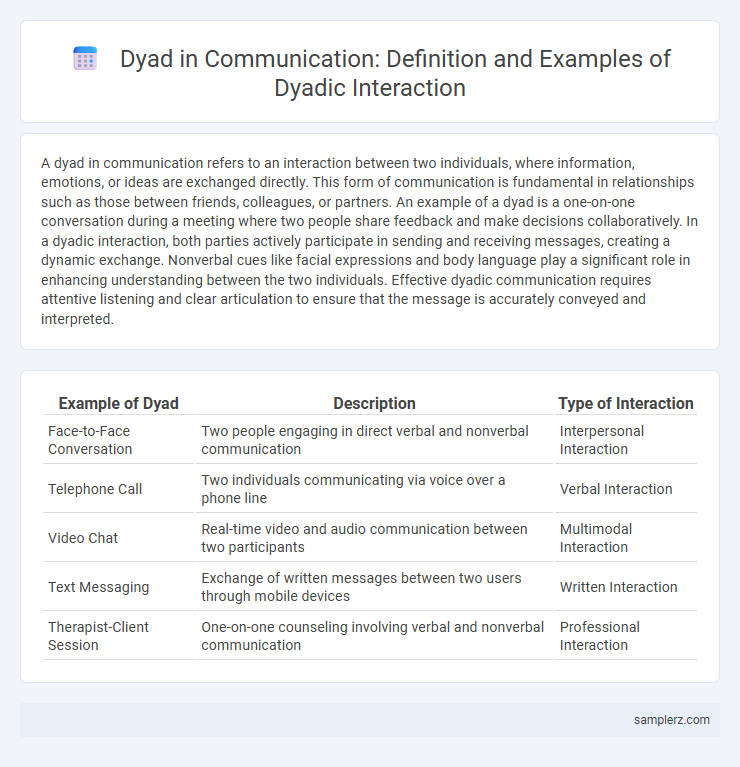A dyad in communication refers to an interaction between two individuals, where information, emotions, or ideas are exchanged directly. This form of communication is fundamental in relationships such as those between friends, colleagues, or partners. An example of a dyad is a one-on-one conversation during a meeting where two people share feedback and make decisions collaboratively. In a dyadic interaction, both parties actively participate in sending and receiving messages, creating a dynamic exchange. Nonverbal cues like facial expressions and body language play a significant role in enhancing understanding between the two individuals. Effective dyadic communication requires attentive listening and clear articulation to ensure that the message is accurately conveyed and interpreted.
Table of Comparison
| Example of Dyad | Description | Type of Interaction |
|---|---|---|
| Face-to-Face Conversation | Two people engaging in direct verbal and nonverbal communication | Interpersonal Interaction |
| Telephone Call | Two individuals communicating via voice over a phone line | Verbal Interaction |
| Video Chat | Real-time video and audio communication between two participants | Multimodal Interaction |
| Text Messaging | Exchange of written messages between two users through mobile devices | Written Interaction |
| Therapist-Client Session | One-on-one counseling involving verbal and nonverbal communication | Professional Interaction |
Defining Dyads in Communication
A dyad in communication refers to a pair of individuals engaged in direct interaction, such as a conversation between two friends or a teacher and student exchange. This two-person unit highlights the foundational element of interpersonal communication, where verbal and nonverbal cues are exchanged to create meaning. Effective dyadic communication involves feedback, turn-taking, and mutual influence, essential for building personal relationships and resolving conflicts.
Characteristics of Dyadic Interactions
Dyadic interactions involve two individuals engaging in direct, reciprocal communication characterized by mutual influence and shared meaning-making. Key characteristics include verbal and nonverbal exchanges, immediacy, and the ability to provide personalized feedback, fostering intimacy and trust. These interactions often exhibit high levels of interdependence, where each participant's behavior significantly impacts the other's responses.
Types of Dyadic Communication
Dyadic communication involves direct interaction between two individuals, encompassing types such as interpersonal, affective, and task-oriented communication. Interpersonal dyadic communication emphasizes personal connection and emotional exchange, while affective focuses on expressing feelings and building rapport. Task-oriented dyads prioritize achieving specific goals through structured exchange of information and problem-solving dialogue.
Common Settings for Dyadic Exchange
Dyadic communication commonly occurs in face-to-face conversations, telephone calls, and video chats where two individuals exchange messages directly. Settings such as personal interviews, counseling sessions, and informal dialogues provide structured environments that enhance clarity and feedback. These interactions emphasize reciprocity and immediate response, crucial for effective understanding and relationship building.
Face-to-Face Dyad Example: Friends in Conversation
A face-to-face dyad occurs when two friends engage in a conversation, allowing for immediate verbal and nonverbal feedback. This interaction includes gestures, facial expressions, tone of voice, and eye contact, all enhancing mutual understanding. The dyadic communication strengthens relational bonds through trust, empathy, and active listening.
Virtual Dyad Example: Online Video Calls
Online video calls exemplify a virtual dyad by enabling real-time, face-to-face communication between two individuals across different locations, enhancing interpersonal connection despite physical distance. This digital interaction relies on platforms like Zoom or Skype that facilitate clear audio-visual exchanges, fostering effective dialogue and emotional expression. Virtual dyads through video calls have become essential in remote work, telehealth, and maintaining personal relationships, demonstrating the adaptability of communication in a digital age.
Workplace Dyad Example: Manager-Employee Dialogue
A workplace dyad often involves a manager-employee dialogue where both parties exchange feedback to improve performance and clarify expectations. This interaction fosters trust, enhances job satisfaction, and promotes effective problem-solving. Clear communication in this dyad reduces misunderstandings and aligns individual goals with organizational objectives.
Therapeutic Dyad Example: Counselor-Client Interaction
The therapeutic dyad between a counselor and client exemplifies a focused interpersonal communication dynamic where active listening and empathetic responses foster trust and understanding. This interaction is grounded in verbal and nonverbal cues that enable the counselor to identify emotional states and tailor interventions effectively. Consistent feedback within this dyad promotes client self-awareness and facilitates behavioral change.
Educational Dyad Example: Teacher-Student Discussion
A teacher-student discussion exemplifies a dyadic communication where both participants actively exchange information to enhance learning outcomes. The teacher uses questioning techniques to assess comprehension, while the student provides feedback and asks for clarification, creating a dynamic interaction. This focused dialogue fosters critical thinking and personalized instruction within the educational environment.
Impact of Dyadic Communication on Relationship Building
Dyadic communication, exemplified by one-on-one conversations, plays a crucial role in relationship building by fostering trust and mutual understanding. The direct exchange of verbal and nonverbal cues allows for immediate feedback, reducing misunderstandings and enhancing emotional connection. This personalized interaction strengthens bonds and promotes collaborative problem-solving within interpersonal relationships.

example of dyad in interaction Infographic
 samplerz.com
samplerz.com